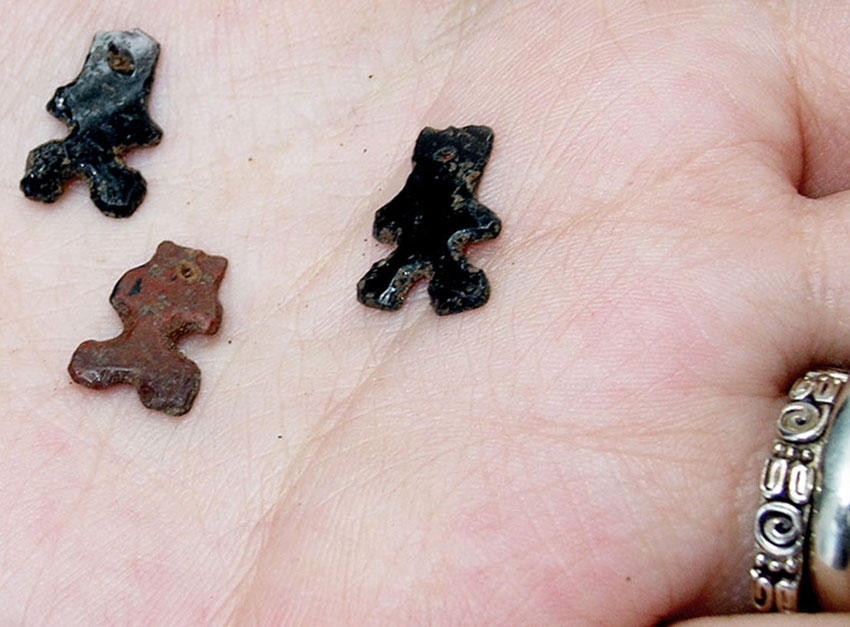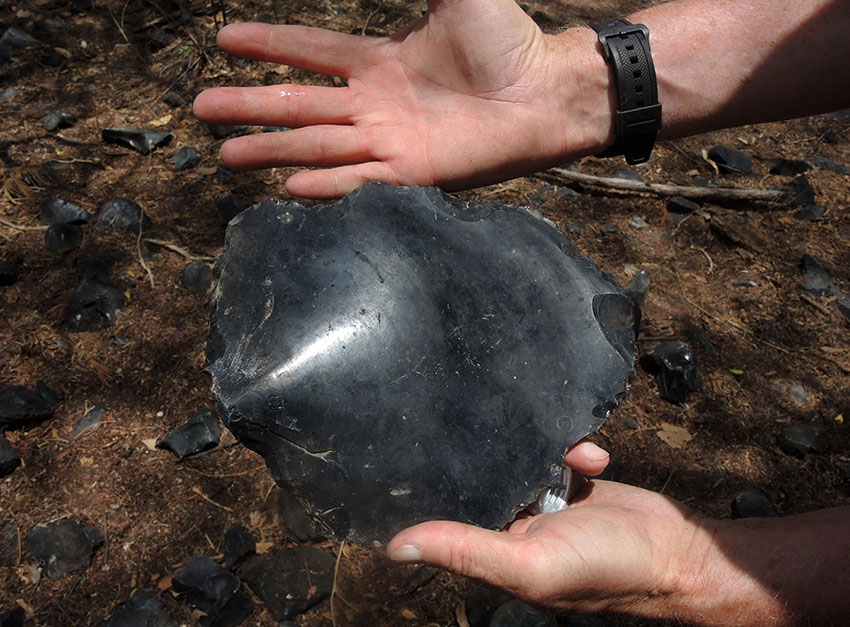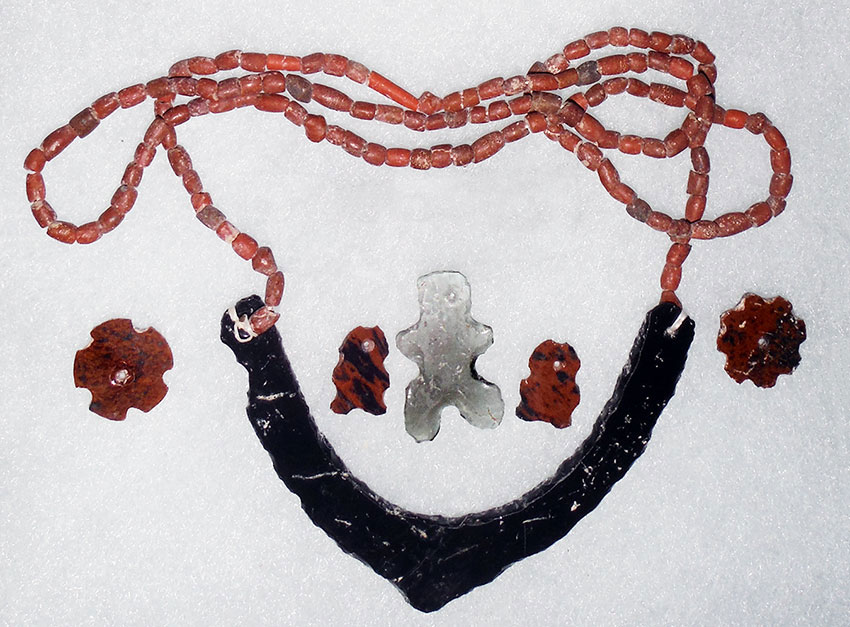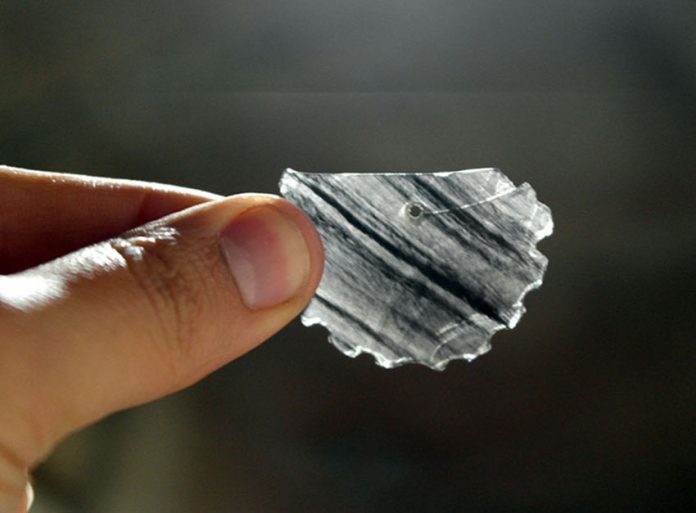I first saw them in the delightful little museum of Ameca, Jalisco, located 60 kilometers west of Guadalajara. There were more than a hundred of them: thin disks of obsidian no more than an inch in diameter, each one with a tiny hole right in the center.
Some museologist had strung them all together (unfortunately using an ugly green plastic cord) to form a shimmering pectoral which was impressive indeed.
I admired the pectoral, but what I couldn’t get out of my mind was the fragility of those disks, some of them as thin as a dime. How had they been made and — all the more intriguing — how could anyone possibly have put a neat little hole through every one of them without shattering the glass? My surprise at the thinness of those disks was based on my own experience trying to help out that druid …
Oops, let me back up a bit.
Obsidian is natural glass that comes from a volcano. Mexico’s state of Jalisco has more sources of obsidian than any other region in Mesoamerica and the fourth largest deposits of the natural glass anywhere in the world.

That’s why “the druid” contacted me. Well, to be more precise, he was an Englishman who desperately needed a disk of green obsidian for what he described as a druidic ceremony.
Now I just happened to know of an excellent source of green obsidian, but my modern-day druid insisted he wanted it in the form of a thin disk one inch in diameter, with a biggish hole in the center, and — via email — he asked me to find a Mexican artisan who could make such a disk.
So, off I went to my favorite obsidian craftsman, Don Eleno, who said, “Claro qué sí, I can make the disk and the hole, but the thinnest I could possibly get it is a quarter of an inch (6.4 mm).”
So, standing there in the Ameca museum in full vision of all those ancient disks, maybe 2 mm thick, I wondered just how those pre-Hispanic artisans had done it.
Soon I learned that many such disks had been found in the vicinity of Tequila Volcano and the first persons to write about them were archaeologists John Clark and Phil Weigand. They declared that the little jewelry disks had not been produced through grinding and polishing (Don Eleno’s technique).
“Percussion was used,” they said, following the obsidian blade-making procedure succinctly described by the 16th-century Spaniard Toribio of Benavente, a Franciscan missionary known as one of the “12 apostles of Mexico.”

“It is in this manner: first they get out a knife stone (obsidian core) which is black like jet and 20 cm or slightly less in length, and they make it cylindrical and as thick as the calf of the leg, and they place the stone between the feet, and with a stick apply force to the edges of the stone, and at every push they give, a little knife springs off, with its edges like those of a razor.”
But what about the hole? How do you pierce a glass disk no thicker than a coin, without breaking it?
Along came another archaeologist, Rodrigo Esparza, who put a couple of these disks under the microscope to find out.
The holes, Esparza told me, are sometimes in the center, but more often near the edge in the pieces found in western Mexico and in a few cases there are two holes, one at each extreme.
“If making a flake is complicated,” commented Esparza, “putting a hole through a sheet of obsidian only two millimeters thick is even more complicated. We decided to analyze the orifice with a stereoscopic microscope and a scanning electron microscope. The results revealed a very sophisticated technology for drilling a hole.
“With the stereoscopic microscope we could see that the surface had been rubbed with sand to facilitate drilling. To start to make the orifice, a very fine auger, perhaps of bone or horn, was used, plus the dust of ground quartz or flint as an abrasive. With different magnifications, we could see that the friction tracks inside the hole were circular and uniform. This suggests that a string-powered drill was used to produce smooth, balanced movement.”

This drilling technique, by the way, contrasts with the system used to perforate similar obsidian disks found near Teotihuacán. Archaeologist Alejandro Pastrana told me that only percussion had been used and when he and his teammates tried to replicate the procedure, “it took more than a thousand tries, over a period of two years, before we succeeded.”
Apart from shiny disks, collectors in western Mexico had also acquired thin obsidian “charms” shaped like animals, humans and even plants. All of these were pierced, suggesting they were designed to be strung on a necklace.
One little problem with all of this — from the point of view of an archaeologist — was that none of the items they were examining were in situ. Without some sort of context, there was no way of determining their age.
Then, in 2002 and 2003, archaeologists discovered several undisturbed tombs in Circle Six of the Guachimontones, the “circular pyramids” located 40 kilometers west of Guadalajara.
“Erick Cach was digging there,”says Rodrigo Esparza, “and out came four little round disks in one of the burials. Well, radiocarbon dating proved that that burial was from 180 to 100 BC.”
Esparza calculated that by the year 100 AD the shiny pierced disks had gone out of style.
[soliloquy id="113844"]
“Who knows why,” says the archaeologist. “Maybe a political change took place, maybe an elite family lost power or maybe this type of jewelry simply went out of fashion.”
Speaking of fashion, just how were these disks used? Stringing them like beads to form a necklace would have been highly impractical. The tiny holes (sometimes only half a millimeter wide) would only admit a slender string which the hole’s sharp edges would soon cut.
Far more logical would have been to sew the discs onto clothing, as spangles and sequins are used today. This would have shown the shiny, mirror-like surfaces to advantage and would have made the wearer sparkle like Elvis.
It’s easy to imagine this truly dazzling figure standing atop one of the Guachimontones, which surely must have functioned as excellent stages, because anyone on top would have been visible to every last one of hundreds of people filling the circle around the mound.
Was the elite, glittering VIP covered with flashing spangles a singer, a dancer, a preacher or a politician? Whatever the case, he or she would certainly get the crowd’s attention.
And there you are. That, I think, is why spangles were all the rage at the Guachimontones in the year 100 BC … and that’s what I call entertainment!
The writer has lived near Guadalajara, Jalisco, for more than 30 years and is the author of A Guide to West Mexico’s Guachimontones and Surrounding Area and co-author of Outdoors in Western Mexico. More of his writing can be found on his website.
